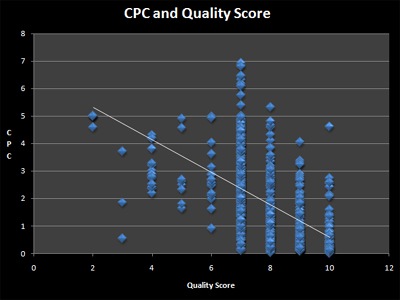I’ve been thinking and talking a lot about Quality Score (for search networks) lately. I usually don’t think much about quality score (QS) and over time, I got fed up with people who were obsessed with it. I suspected it was just people’s fascination with mysteries- Google algorithms cause a lot of discussion because they’re complicated and partly secret. But I figured, if you create ad groups that make sense and test good ads, QS takes care of itself.
PPC Account Average Quality Score
I had never thought of it, but it suddenly made a lot of sense to find the average quality score for all keywords in each of our client accounts. Quality score, if you get it from the Reporting Center, is on a 1-10 scale. I found that our average client had an average quality score of about 7.5. But they ranged from 6.1 to 8.2. I also profiled their total number of keywords, number of ad groups, avg CPC, what vertical they’re in, and average ad position.

The above is a scatter chart of a selection of the quality score and CPC of about 700 keywords across about ten of our PPC clients. As we’d expect, there’s an inverse relationship between QS and CPC.
Now, average quality score is just an indicator, and not perfect. You might use it to question if your account could be structured better or not. If you get more granular, if you increase CTR, you can lower CPC for the same ad position and increase ROI. Yes, there’s a balance between CTR and CR and Avg Sale- you can optimize for all by focusing on ROAS or ROI. But lower CPC also gets you more clicks and more impressions for the same budget. So when you consider all the factors, choosing a KPI is not as easy as it looks. Dealing with a suite of KPI’s could be too complicated.
Number of Keywords and Average Quality Score
You should also think about how many keywords you have. Every niche has a different number of relevant keywords, and within that, a different number of high ROI keywords. If you have too many keywords, your quality score may go down, because your offer is truly relevant to only so many search keywords, and CTR will decrease when you pass beyond some critical point of relevance. On the flip side, you could get a very high QS by using fewer keywords, but then are you missing out on important customers?
Average Quality Score and Your Bottom Line
And never forget- the most important keywords are the ones that perform the best for your KPI- the most profitable, the most volume-producing keywords… the quality score of these keywords is more important than the quality score of 100 long tail keywords, if the long tail ones don’t produce much ROI. So, take the average quality score for an account with a grain of salt.
Quality Score = CTR, Says AdWords Rep
Another interesting point I had clarified by one of our AdWords Dedicated Support reps was that though Quality Score is composed of multiple factors, far and away the most important one is CTR. He said:
In actuality, the CTR is really the largest component of Quality Score. If you increase the CTR, you will increase the Quality Score. It can be pretty tough to get scores of 9-10, but it is definitely possible. More often than not though, the keywords I see in accounts that have scores of 9-10 are branded keywords that have very high CTRs (sometimes 10-20-30%).
This is not surprising, when you think about it, that AdWords defines quality as the relevance that leads to clicks- that’s their bottom line- Google is still not fully devoted to your success- they only take you part way through the journey. You have to fight for the conversions and increased revenue. And they’re not wrong to do that- they’re not responsible for the effectiveness of your website usability, your offer, your copywriting and so on.
So, How Then Shall We Optimize?
The way to lower CPC via increasing QS is to increase CTR. And that brings us back to where I started with quality score- when you test ads, you need to balance CTR, CR, and Avg Sale optimization. Clicks alone are not your goal, and high CTR ads sometimes are low ROI ads.
When it comes to campaign and ad group structuring and how much of your keywords are in their ad group’s ads, that’s where you can increase CTR and QS without worrying. The more granularity you have at the campaign level, the more you can optimize by budgeting, but you can start something as an ad group and move it into its own campaign later- quite easily in fact with AdWords Editor. And it makes sense to prioritize this above ad testing, even though I believe in constant ad testing, because ad success can be limited by bad ad group structure.
Brian Carter is the Director of Search Engine Marketing for Fuel Interactive, an interactive marketing agency in Myrtle Beach, South Carolina. He is responsible for the SEO, PPC, SMM, and ORM programs at Fuel and its partner traditional agency Brandon Advertising & PR.




